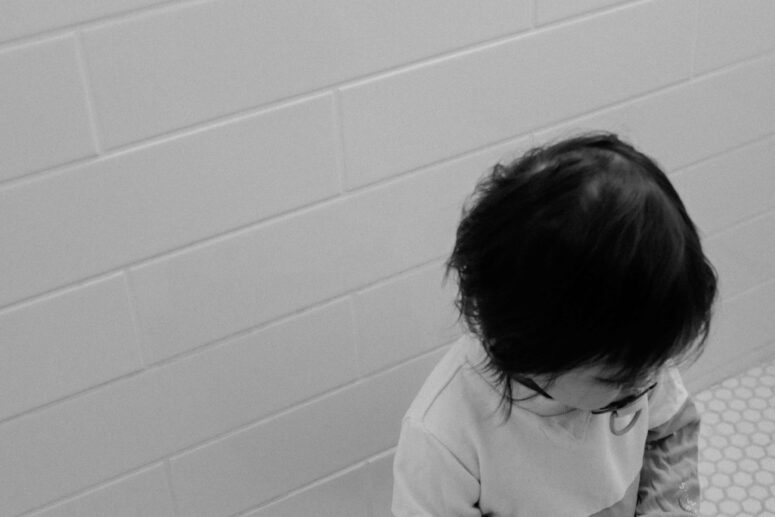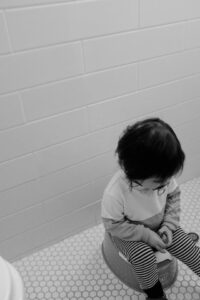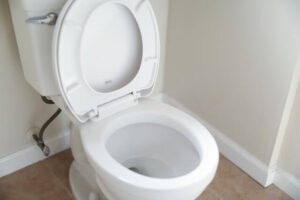
Table of Contents
Children with autism can be potty trained, but the process may take a lot of time and effort. In addition to communication delays, most autistic children have sensory issues that cause resistance to using the toilet. ABA therapy in home can significantly aid in overcoming these challenges. In this article, we answer the most common questions about autism and potty training.
Can a Child With Autism Be Potty Trained?
For children diagnosed with autism spectrum disorder, transitioning from diapers to using a toilet can be extremely challenging. But just like any other skill, potty training can be successfully taught with lots of persistence and patience.
It is essential to take time to potty train your autistic child. Not only will it help them avoid the physical discomfort of wearing diapers, but will boost their self confidence and improve their quality of life.
Before you start
Before you start potty training your child, you should consult a pediatrician to rule out any medical issues. Some underlying conditions may prevent your child from effective toilet training despite your best efforts.
Although most children on the autism spectrum eventually learn to use the toilet, the process may take a long time. The average age when children with autism become potty trained is 3.3 years, compared to 2.5 years for children with other developmental disabilities and 2.3 years for neurotypical children.
Let’s see when is the best time to start potty training.
At What Age Should You Potty Train Your Autistic Child?
As a general rule, you should start potty training as soon as you feel that your child is ready.
Here are some signs to watch for.
What Are the Signs That a Child With Autism Is Ready to Be Potty Trained?
If your child shows some or all of the following signs, it’s time to start with potty training:
- Your child has acquired gross and fine motor skills necessary for using the toilet, such as maintaining balance and stability and unfastening the clothes.
- Your child can sit on the toilet, a potty, or a toilet training seat without assistance.
- Your child is able to follow simple instructions like “sit on the toilet.”
- Your child knows where the bathroom is located in your home.
- Your child stays dry for at least two consecutive hours during the day as well as after naps. This is an indicator of sufficient bladder and bowel control.
- Your child dislikes the feeling of a wet diaper and shows it either by pulling off the diaper or gesturing that the diaper is wet or soiled.
- Your child sits on the toilet or flushes the toilet without being prompted to do so.
- Your child lets you know when to change the diaper, for example, by leading you to the bathroom to get a clean diaper.
Teaching your autistic child to use the toilet requires careful planning. It is recommended to proceed with the training in several phases to make the transition as seamless as possible for your child. Continue reading to learn more.
How to Potty Train an Autistic Child?
Effective potty training of an autistic child is done in three phases: planning phase, setup phase, and implementation phase.
Planning phase
The planning phase consists in preparing everything you’ll need for potty training, for example:
- Toilet training seat or a transitional potty
- A footstool if your child needs support
- A timer
- Toilet paper or flushable toilet wipes which are easier to use
- Two weeks’ worth of underwear
- A basket filled with fun activities and toys to keep the child entertained
- A reinforcement basket with rewards like your child’s favorite toys, stickers, and treats
- Visual support such as picture cards, potty training books, and social stories
- Toilet training data sheet where you will track the success of toilet training. You can purchase data sheets for download here.
Setting up phase
When you have all the items ready, you can start setting up the bathroom. If you have more than one bathroom in your home, designate the one that your child feels most comfortable using for training. Here’s what you should do:
- Position a toilet training seat on the toilet
- Alternatively, place a transitional potty in the bathroom.
- Place your child’s underwear, toilet wipes, and the timer in the bathroom.
- Place the activity basket within reach of your child. It is important that your child has easy access to books and toys without having to get up from the toilet.
- Hide the reinforcement bin so that your child can’t see the rewards.
- Display picture cards or other visual support close to the toilet where your child can easily see them.
- Tape the toilet training data sheet on the wall outside of the bathroom.
Implementation phase
The implementation phase of potty training a child with autism takes a lot of time and patience. Here are some rules to follow:
Be consistent
Take your child to the bathroom every twenty minutes and ask them to sit on the toilet for only five minutes. You can keep the child entertained by reading books or letting them play with the toys from the activity basket. Repeat this process throughout the day. At night, your child can continue using a diaper.
Gradually decrease the frequency of bathroom visits
After some time, your child will start peeing or pooping more either in the morning or afternoon. This is when you can decrease the frequency of bathroom visits to every thirty minutes, and then an hour.
Keep the same task sequence
Most children on the autism spectrum are dependent on routines and it is essential to keep the same task sequence to avoid confusion and frustration.
Provide clear instructions
Using specific language will make it easier for your child to understand what they are supposed to do. What’s more, all family members should use the same word to refer to going to the toilet, such as potty or bathroom.
Use praise and rewards
Positive reinforcement in the form of rewards is an efficient method for toilet training children with autism. The rewards, ranging from a praise, a hug, or a favorite activity, must be immediate and consistent in order for your child to understand that they are related to a specific behavior.
Visual supports for potty training
Many children with autism are visual learners. Using visual cues and prompts such as picture cards, social stories, or toilet training books, is an excellent way to motivate your child during potty training.
Picture cards
Picture cards can help your child visualize the sequence of actions that are required for going to the toilet, for example:
- Pull pants down
- Pull underwear down
- Sit on the toilet
- Pee or poop in the toilet
- Wipe
- Pull underwear up
- Pull pants up
- Flush the toilet.
You can download and print toilet training picture cards for free, for example, this potty training visual schedule and these toilet picture cards.
PECS icons
You can also create a step-by-step visual sequence of the toilet routine for your child with the help of Picture Exchange Communication System (PECS) icons.
Social stories
Toilet training involves many steps that your child may find confusing. Personalized social stories can help your child cope with the new situation. Social stories are written from the child’s perspective and explain in detail what are the actions they are expected to take. Read the story with your child several times every day until the process becomes easier.
If you need assistance with creating a potty training social story, your child’s speech or occupational therapist can help you make one.
Toilet training books
Books about potty training are helpful in visualizing the process. Below, we list books suitable for children with autism:
- Life… with a Side of Autism: Teaching My Autistic Child How to Use the Potty (Amazon)
- Time to Pee (Amazon)
- On Top of the Potty (Amazon)
- Ready, Set, Potty!: Toilet Training for Children with Autism and Other Developmental Disorders (Amazon)
- Bear in the Big Blue House – Potty Time With Bear (Amazon)
Toilet training apps
If your child is non-verbal, toilet training apps can be a useful and fun tool for potty training.
- AvaKid See Me Go Potty is a communication app that can help your child tell you when they need to go to the toilet.
- Potty Training Social Story, customizable for boys or girls, is specifically designed to help sensitive children not to get overwhelmed when potty training.
- Children’s Countdown Timer – Visual Timer for Kids will remind your child when it’s time to try going potty. You can set it at thirty-minute intervals, for example.
When To Take a Break From Potty Training
Sometimes, your child is simply not ready for potty training and it’s better to take a break and try again in a couple of weeks. You should stop toilet training if you notice that:
- Your child is very resistant to potty training
- Going to the bathroom is regularly accompanied by tears and meltdowns
- Your child is having lots of accidents during the day
- There is no sign of progress for several weeks.
You should wait until your child becomes ready to make sure that toilet training is a positive experience. If you need additional support, you can consult your child’s occupational therapist or early intervention service, like your child’s ABA therapist.
However, if there’s no improvement for a few weeks, it is advisable to see your child’s pediatrician. There may be an underlying medical issue behind your child’s resistance to going to the toilet, such as constipation or urinary tract infection.
Issues That Parents Face When Potty Training Their Child with autism
When potty training your child with autism, you can expect to meet many challenges. Here are some of the most common issues:
What if my child is afraid of the toilet?
Some autistic children are afraid of the toilet to the point that they refuse to enter the bathroom. If this is the case with your child, start the training by using a potty placed in another room. The transition into the bathroom can happen gradually. Alternatively, ask your child to sit on the toilet with the seat down at first and then on a training seat.
What if my child is afraid to have a bowel movement?
It is quite common for autistic children to hold in bowel movements when they are being potty trained. If your child is afraid of bowel movement, you can ask the child to poop in the diaper while in the bathroom. Then they can slowly transition to pooping in the diaper when sitting on the toilet and eventually sitting on the toilet with the diaper off.
What if my child is afraid of flushing the toilet?
Autistic children with sensory issues may get overwhelmed by the sound of flushing the toilet. Tell your child in advance that you are going to flush the toilet and make this task a part of the visual support. To start with, you can let your child leave the bathroom when you flush the toilet. Once the child becomes more confident, he or she can stay in the bathroom while using earplugs or headphones and then eventually try flushing on their own.
What if my child has an excessive interest in flushing the toilet?
Not all autistic children are afraid of the sound of flushing. On the contrary, some are fascinated by it and it may be difficult to get them to leave the bathroom. Explain to your child that flushing can be done once when there is pee or poop in the toilet. Some parents choose to put a visual stop sign on the toilet or keep the bathroom door closed to prevent the child from entering.
What if my child wants to play with the toilet water?
Explain to your child that playing with the toilet water is not acceptable. Instead, divert their attention from the toilet and let your child play with water in the sink or bathtub and place safety catches on the toilet.
What if my child wants to play with toilet paper?
Start by telling your child that toilet paper can be used only for wiping after going to the toilet. You can also keep the toilet paper out of the child’s reach and use tissues or wipes instead.
Teaching a Child to Ask to Use the Bathroom
Teaching your child to communicate the need to use the bathroom will make the potty training process much easier. If your child has limited verbal abilities, encourage communication through signing or PECS cards, for example. Children who use assisted communication devices need to have a picture of a toilet that they can press to indicate that they want to go to the bathroom.
Nighttime Potty Training
Nighttime potty training, in particular, can be difficult due to the child’s limited communication skills, sensory sensitivities, and difficulties with transitioning from sleep to wakefulness. Here are some strategies that parents can use to help potty train their child with autism for the night:
- Establish a consistent bedtime routine: Children with autism may have difficulty transitioning from one activity to another, so it’s important to establish a consistent bedtime routine to help them prepare for sleep. This routine can include activities such as a bath, reading a story, and using the bathroom before bed.
- Use visual aids: Children with autism often respond well to visual aids, so parents can use pictures or social stories to help their child understand the potty training process. Visual aids can also help the child understand the steps involved in going to the bathroom during the night.
- Limit fluids before bedtime: To reduce the chances of bedwetting during the night, parents can limit the child’s fluid intake before bedtime. This can include avoiding drinks for at least an hour before bedtime and encouraging the child to use the bathroom before going to sleep.
- Use a bedwetting alarm: Bedwetting alarms can be an effective tool for potty training children with autism. These alarms use moisture sensors to detect when the child has wet the bed and sound an alarm to wake them up, encouraging them to use the bathroom.
- Practice positive reinforcement: Positive reinforcement can be an effective tool for potty training children with autism. Parents can offer rewards, such as stickers or small toys, for successful trips to the bathroom during the night.
It’s important to remember that potty training can be a gradual process, and each child with autism will progress at their own pace. By using consistent routines, visual aids, limiting fluids, using bedwetting alarms, and positive reinforcement, parents can help their child develop the skills necessary for nighttime potty training.
Useful tips for potty training
- Using a potty will require an additional transition to toilet training. It is often easier to immediately start putting your child on the toilet or using a toilet training seat. This way, you will avoid introducing more changes during the toilet training process, which may be confusing for your child.
- It is essential that everyone who participates in your child’s potty training follows the same routine to ensure efficient training.
- Try not to focus on accidents and only briefly remind your child to use the toilet next time.
- Make sure that your child uses underwear as soon as you start potty training. Your child will associate accidents with wetness and discomfort and be motivated to use the toilet.
- In the first weeks of potty training, encourage your child to eat salty foods so that he or she drinks more fluids throughout the day.
- Sitting on the toilet may be difficult for a child with sensory issues. If this is the case, ask your child to practice a few minutes each day until using the toilet becomes less overwhelming.
- Peeing and pooping should be two separate parts of toilet training. Once your child has learned to pee in the toilet, you can start with poop training.
- Toilet training will take time. Try to stay calm and positive and don’t rush the process. As long as your child is positive toward potty training and is making progress, you can continue with the training.
- The more your child practices, the easier the process will become. Your child will eventually become more positive towards using the toilet.
Hand Washing
Washing hands is the last step in the potty training routine. Just like you did when teaching your child to use the toilet, you should follow the same sequence of tasks each time:
- Turn on the water
- Wet the hands
- Rub the soap into hands
- Rinse hands
- Turn off the water
- Dry hands.
You can also create a step-by-step visual sequence of the hand washing routine using the PECS icons. Just make sure to place them at the child’s eye level near the sink.
Should hand washing be taught at the same time or will it confuse your child?
Hand washing should be taught separately from potty training. Autistic children often have difficulties concentrating on multiple tasks and learning potty training and hand washing at the same time can be confusing.
If you are ready to work with the best ABA therapy provider in New York, New Jersey or Indiana, give us a call at (732) 402-0297. Our dedicated team is ready to help and we will treat you like family.
- Autism Routine Disruption in Adults: Coping Tips - July 16, 2024
- Autism and Obsession: An Overview - July 16, 2024
- Autism and Taking Clothes Off: Management Tips - July 16, 2024


